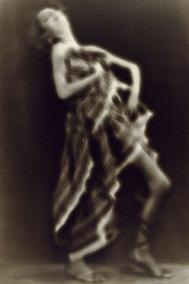Students will learn about axial movements and locomotor movements by discussing dancers depicted in a drawing and photograph. They will then practice combining axial and locomotor movements. They will describe how artists depict a dancer's motion in drawing and photography. They will also analyze how an artist creates movement and emphasis through contrast, composition, and leading lines, and then experiment with photography to capture motion in dance.
|
 |
 |
 |
Students will be able to:
• understand how visual art can capture the motion of dance.
• describe and demonstrate various types of axial and locomotor movements.
• experiment with contrast, composition, and line to capture motion with photography.
• create blurred motion effects with photography.
|
 |
 |
 |
Download the complete lesson by clicking on the "Download this lesson" icon above.
Glossary Terms:
Words in bold on these pages and in the lesson are defined in the glossary for this curriculum (see "Performing Arts in Art Contents" links above). |
 |
 |
 |
| Juliet Dancing, Man Ray, 1945. © Man Ray Trust ARS-ADAGP
|
 |
|
 |
Common Core Standards for English Language Arts
Grades 6–8
SPEAKING AND LISTENING
Comprehension and Collaboration
1. Prepare for and participate effectively in a range of conversations and collaborations with diverse partners, building on others' ideas and expressing their own clearly and persuasively.
2. Integrate and evaluate information presented in diverse media and formats, including visually, quantitatively, and orally.
Visual Arts Content Standards for California Public Schools
Grade 6
1.0 Artistic Perception
1.1 Identify and describe all the elements of art found in selected works of art (e.g., color, shape/form, line, texture, space, value).
1.3 Describe how artists can show the same theme by using different media and styles.
2.0 Creative Expression
2.4 Create increasingly complex original works of art reflecting personal choices and increased technical skill.
4.0 Aesthetic Valuing
4.1 Construct and describe plausible interpretations of what they perceive in works of art.
Grade 7
1.0 Artistic Perception
1.4 Analyze and describe how the elements of art and the principles of design contribute to the expressive qualities of their own works of art.
4.0 Aesthetic Valuing
4.2 Analyze the form (how a work of art looks) and content (what a work of art communicates) of works of art.
Grade 8
1.0 Artistic Perception
1.1 Use artistic terms when describing the intent and content of works of art.
2.0 Creative Expression
2.3 Create an original work of art, using film, photography, computer graphics, or video.
4.0 Aesthetic Valuing
4.2 Develop a theory about the artist's intent in a series of works of art, using reasoned statements to support personal opinions.
4.3 Construct an interpretation of a work of art based on the form and content of the work.
Dance Content Standards for California Public Schools
Grade 6
1.0 Artistic Perception
1.1 Demonstrate focus, physical control, coordination, and accurate reproduction in performing locomotor and axial movement.
Grade 7
3.0 Historical and Cultural Context
3.3 Explain how dance functions among people of different age groups, including their own.
Grade 8
2.0 Creative Expression
2.4 Record personal movement patterns and phrases, using a variety of methods (e.g., drawings, graphs, words). |
 |

|
 |




